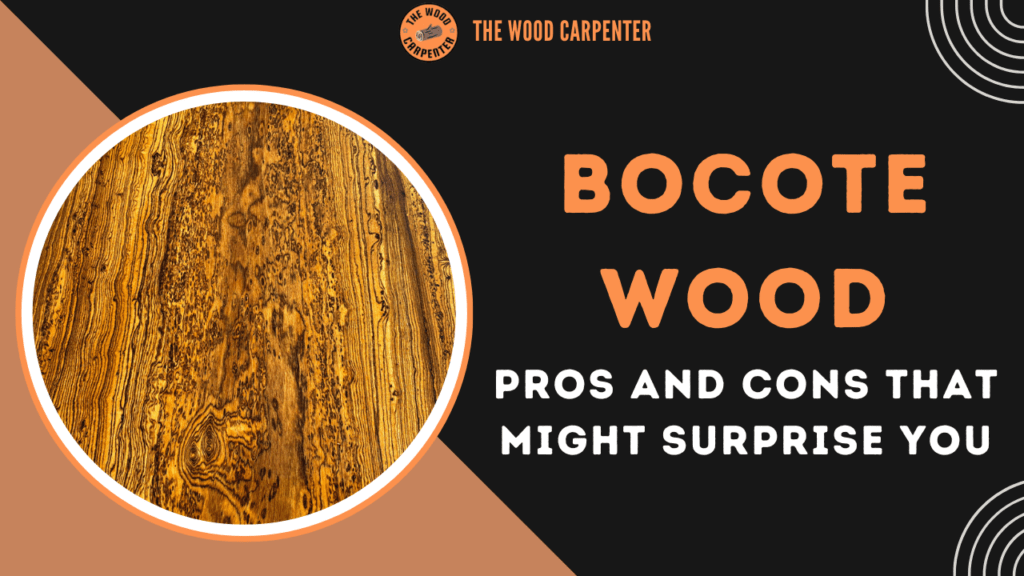
It is one of the most beautiful and useful exotic hardwoods accessible today. Bocote is a popular choice for high-end furniture, musical instruments, ornamental objects, and specialty crafts because of its dramatic grain, rich color range, and long-lasting quality.
It comes from Mexico and Central America. This detailed guide goes over bocote’s distinctive qualities, useful uses, advantages and cons, and addresses the most common questions people have about this beautiful wood.
What Is Bocote Wood ?
Bocote refers to several species in the Cordia genus, most notably Cordia elaeagnoides and Cordia alliodora. These trees can reach heights of 65–100 feet with trunk diameters up to 5 feet, thriving in the warm climates of Mexico, Central America, and parts of South America.
Appearance
Color: Bocote’s heartwood ranges from golden yellow to brown, often with bold, almost black striping or swirling patterns. The color deepens and darkens with age, enhancing its visual appeal.
Grain: The grain is typically straight or slightly interlocked, but flatsawn boards often display wild, dramatic patterns including “eyes” and heavy figuring.
Texture: Bocote has a medium to fine texture with a naturally oily, waxy feel and a high natural luster.
Density and Hardness
Bocote is a dense, heavy wood with an average dried weight of 53 lbs/ft³ (850 kg/m³) and a Janka hardness of 2,010 lbf. This makes it harder and more durable than many domestic hardwoods, well suited for items that must withstand wear and tear.
Key Properties
| Property | Details |
| Botanical Name | Cordia spp. (mainly C. elaeagnoides, C. alliodora) |
| Origin | Mexico, Central America |
| Color | Golden yellow to brown with dark stripes |
| Grain | Straight to wild, often with eyes and swirls |
| Hardness | 2,010 lbf (Janka) |
| Density | 850 kg/m³ (53 lbs/ft³) |
| Durability | Moderately to very durable; resists rot, but can attract insects |
| Workability | Easy to machine and finish, but can dull tools |
| Odor | Distinct “dill pickle” scent when cut |
| Sustainability | Not listed as threatened or endangered |
Uses of Bocote Wood
Bocote’s unique appearance and physical properties make it highly sought after for a variety of applications:
Fine Furniture & Cabinetry: Bocote is a showstopper in custom furniture, cabinets, and paneling, where its bold grain can be showcased.
Musical Instruments: Its density and resonance make it ideal for guitar backs, sides, and other instrument parts.
Turned Objects: Bocote is popular for pens, bowls, and decorative turnings due to its workability and beautiful finish.
Knife & Tool Handles: The wood’s hardness and moisture resistance make it a premium choice for handles.
Flooring & Veneer: Its durability and visual impact are perfect for high-end flooring and decorative veneers.
Boatbuilding & Outdoor Uses: While durable, it should be protected from insects for long-term outdoor use.
Also read:
Iroko Wood: Strong, Stylish, But Is It Right for You ?
What Makes Paulownia Wood So Special ?
Workability
Bocote is generally easy to work with both hand & machine tools. Its natural oils help it finish to a high luster, but can sometimes interfere with gluing—using appropriate adhesives and surface preparation is recommended.
The presence of silica in some boards may dull cutting edges more quickly than other woods, so sharp carbide tools are best.
Machining: Cuts cleanly, but interlocked grain can cause tear-out.
Sanding: The oily surface may clog sandpaper; frequent cleaning is advised.
Gluing: Usually trouble-free, but wipe surfaces with solvent before gluing.
Finishing: Takes oil, lacquer, and varnish well, highlighting its dramatic grain.
Durability and Maintenance
Bocote is rated from moderately to very durable in terms of rot resistance, making it suitable for both indoor and some outdoor applications. However, it can be susceptible to insect attacks, so regular inspection and maintenance are important for pieces exposed to the elements.
Cleaning: Use mild soap and water; avoid harsh chemicals.
Sealing: Apply a high-quality wood sealer every few years for outdoor use.
Oiling: Regular oiling helps maintain its natural sheen and prevents drying.
Pros and Cons of Bocote Wood
| Pros | Cons |
| Striking, unique grain patterns | Can be expensive compared to domestic hardwoods |
| Dense, hard, and durable | Susceptible to insect attack |
| Easy to work and finish | Silica content can dull tools |
| Resistant to rot and moisture | Oily surface may complicate gluing |
| High natural luster and beautiful aging | Moderate risk of allergic reactions in some people |
| Versatile: suitable for fine furniture, turning, and musical instruments | Limited board sizes; wide planks are rare |
Bocote Wood FAQ
1. What makes bocote wood so visually unique?
Bocote’s dramatic stripes, swirls, and “eyes” set it apart from most hardwoods. Its color ranges from golden yellow to dark brown, often with nearly black figuring, creating a bold, artistic look in any application.
2. Is bocote wood strong enough to use outside?
Bocote is moderately to highly strong and doesn’t rot easily, however bugs can get to it. Sealing and regular maintenance are quite important for projects that will be outside.
3. How does bocote compare up against rosewood or walnut?
Bocote is similar to rosewood in several ways, such how dense it is and how nice it looks, but it is usually cheaper and easier to get. It is tougher and heavier than walnut, and its texture is usually more striking.
4. Is bocote wood difficult to work with?
Generally, bocote is easy to machine and finish, but its density and occasional silica content can dull tools. The oily surface may require special preparation for gluing, but it turns and finishes beautifully.
5. Does bocote wood have any health risks?
Some people may develop skin or respiratory sensitivities, especially if already allergic to other exotic woods like rosewood or cocobolo. Always use dust protection and proper shop hygiene.
6. What are the most common uses for bocote?
Bocote is used in fine furniture, cabinetry, flooring, musical instruments, turned objects, inlays, and knife handles—anywhere visual impact and durability are desired.
7. Is bocote wood sustainable?
Bocote is not listed as threatened or endangered, and selective logging practices help maintain its sustainability.
8. What does bocote wood smell like?
When worked, bocote releases a moderate odor often compared to dill pickles, which many woodworkers find distinctive and not unpleasant.
9. How should I finish bocote wood?
Bocote takes oil, lacquer, and varnish well. A clear finish is usually best to showcase its grain. Wipe oily surfaces with solvent before gluing or finishing for best results.
10. Where can I buy bocote wood?
Bocote is available at specialty lumber retailers and online exotic wood suppliers. Prices typically range from $27 to $40 per board foot, reflecting its premium status.

